|
|
|
Sort Order |
|
|
|
Items / Page
|
|
|
|
|
|
|
| Srl | Item |
| 1 |
ID:
132371
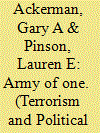

|
|
|
|
|
| Publication |
2014.
|
| Summary/Abstract |
In recent years, much of the literature on terrorist pursuits and use of unconventional weapons has focused on al-Qaeda and other Islamic extremist groups. Some scholars posit lone actors may differ from organizations when it comes to the observation that larger organizations are more likely to engage in chemical, biological, radiological, and nuclear (CBRN) activity, but leave this as an open question because of a prior lack of data on lone actors. Furthermore, new technologies and expanding networks may also spawn more deleterious lone actors, including what have been referred to as "super-empowered individuals." This article utilizes the Profiles of Incidents Involving CBRN by Non-State Actors Dataset and the Radiological and Nuclear Non-State Actors Database to illustrate the characteristics of CBRN pursuit by lone wolves and autonomous cells over time. Initial findings confirm the general perceptions that, historically, lone actors have engaged in cruder, smaller scale, and less frequent CBRN plots and attacks than their formal terrorist organization counterparts, but suggest that such actors do present a genuine threat, at least in terms of the potential for mass disruption. Additionally, while they share several similarities with more formal organizations, lone actors and autonomous cells tend to be motivated less by collective religious or ethno-nationalist concerns than larger organizations, focusing more on narrow or solipsistic drivers. Lone actors and autonomous cells also appear to largely calibrate their CBRN ambitions to their capabilities and their CBRN actions tend to receive better media coverage than formal terrorist organizations.
|
|
|
|
|
|
|
|
|
|
|
|
|
|
|
|
| 2 |
ID:
172053
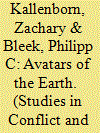

|
|
|
|
|
| Summary/Abstract |
Terrorists combining motivations and capabilities to conduct significant chemical, biological, radiological, or nuclear (CBRN) attacks are, logically and empirically, outliers. Certain characteristics of radical environmentalism heighten the risk of such outliers. The majority of even radical environmentalists embrace nonviolence. Those who turn violent mostly do so in limited ways due to a combination of motivations and capabilities. Fringe elements are motivated to commit large-scale—including CBRN—violence, but are mostly constrained by capability. Yet eco-radicalism also draws more capable adherents. If serious CBRN terrorism attacks occur—a risk about which analysts differ markedly—radical environmentalist fringe actors are plausible perpetrators.
|
|
|
|
|
|
|
|
|
|
|
|
|
|
|
|
| 3 |
ID:
142258
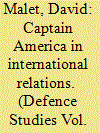

|
|
|
|
|
| Summary/Abstract |
Biological weapons are typically associated with rogue states and terrorist groups; germ weapons used by weak actors against the strong. This article makes a contrary argument, that the emerging use of biotechnology by the United States, China, and other hegemonic powers is likely to afford them a new Revolution in Military Affairs (RMA), one at least as significant as the introduction of the information technology RMA that gave the United States a dominant edge over potential adversaries at the end of the Cold War. It examines recent developments and current R&D programs that call into question the rights of enemy combatants, civilian populations in target areas, and soldiers who will be physically augmented to pursue battlefield objectives. Examples include the Quikclot used to reduce fatalities in the Iraq War, which arguably prolonged public support for the war, and the Pentagon’s publicly detailed research across various programs to create super-soldiers akin to super-heroes. The real advances in biotech will likely only further retrench the major powers of the international system by conferring an asymmetric advantage far beyond the capacity of weaker actors to match.
|
|
|
|
|
|
|
|
|
|
|
|
|
|
|
|
| 4 |
ID:
102728
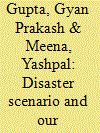

|
|
|
| 5 |
ID:
092304
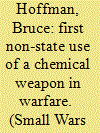

|
|
|
|
|
| Publication |
2009.
|
| Summary/Abstract |
This article presents research conducted by the author in Sri Lanka to verify the first non-state use of a chemical weapon in warfare. This 1990 incident involved a primitive chemical attack perpetrated by the Liberation Tigers of Tamil Eelam (the LTTE or Tamil Tigers) on a Sri Lankan Armed Forces (SLAF) encampment in East Kiran, in the Batticaloa district of Sri Lanka. The article first describes the incident itself, before providing a brief description of the LTTE, its background, and the influence of its leader, Velupillai Prabhakaran. The article then analyzes the attack and places it within the context of theories about potential terrorist and insurgent use of unconventional weapons, such as chemical warfare agents. The research reported here is of interest not only because of the unique, opportunistic dimension of the attack, but also because its conclusions challenge the conventional wisdom about likely terrorist and insurgent use of these unconventional weapons and sheds new light on their interest and intentions in employing such weapons and tactics.
|
|
|
|
|
|
|
|
|
|
|
|
|
|
|
|
| 6 |
ID:
175741


|
|
|
|
|
| Summary/Abstract |
The threat of chemical, biological, radiological and nuclear (CBRN) terrorism is widely attributed to collective actors based on a religious ideology, e.g. globally operating Salafi-jihadist groups like al-Qaeda or ISIL. Only limited attention has been given to the CBRN threat of violent domestic extremists in general or far-right terrorists specifically. Nevertheless, a number of incidents involving far-right activists and CBRN agents in Western countries are known to the public, even though these have had comparatively little impact on public threat perception. This study systematically collected public information about far-right CBRN incidents to identify their main characteristics. The authors were able to identify 31 incidents in Western countries since 1970, which display features contrary to generally assumed forms of CBRN terrorism. Far-right CBRN terrorism appears to be predominantly a lone-actor phenomenon oftentimes involving middle-aged and comparatively well-educated male perpetrators, mostly motivated by non-religious forms of far-right ideology (i.e. neo-Nazism, non-religious white supremacism) and indiscriminately targeting victims. Overall, far-right actors attempting to weaponize CBRN agents have been few and generally technically inept. However, the characteristics of the plots pose potential challenges for effective counter-measures and intervention, should the number of actors or the technical sophistication of plots increase in the future.
|
|
|
|
|
|
|
|
|
|
|
|
|
|
|
|
|
|
|
|
|